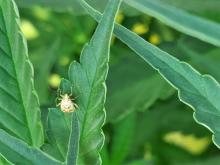Includes:
Western tarnished plant bug (Lygus hesperus)
Pale legume bug (Lygus elisus)
Tarnished plant bug (Lygus lineolaris)
Pest description and crop damage Lygus bugs (Order: Hemiptera; Family: Miridae) are found on many field crops throughout PNW. Lygus hesperus and L. elisus are the most common species of lygus bugs in the PNW. In general, lygus bug adults are 4.4 to 6.3 mm long and 2.1 to 2.8 mm wide. Their body is marked with a V-shaped or triangular mark on the back (scutellum). Color ranges from light green to shades of brown or black. Nymphs are 0.04 to 0.25 inch in length, green or yellow-green, with black spots on the back. In the PWN, lygus bugs can occur on hemp plants throughout the growing season, but higher numbers can be found on late July to mid-August, coinciding with hemp flowering stage. Currently, it is unknown whether lygus bugs can cause economic damage to hemp plants.
Biology and life history Lygus species feed on many different plants including weeds, crops, and native species. Alfalfa and quinoa fields often develop very large populations of lygus from which the insects may colonize hemp. Lygus can be found throughout the growing season and are common all over the PNW. They usually complete three or four generations each year.
Scouting and thresholds Lygus are easily found during normal scouting operations using a beating sheet/tray technique or with a vacuum sampler (i.e., inverted leaf blower) or by observing insect activity while walking through the crop. Both adults and nymphs of all sizes are likely to be present at the same time. There are no established treatment thresholds for lygus in hemp.
Management-biological control
Generalist predators such as big-eyed bugs, lady beetles and damsel bugs, are known to prey on lygus adults and nymphs. There are also braconid wasp parasitoids attacking lygus in the PNW.
Management-chemical control
See:

